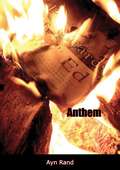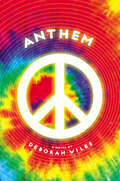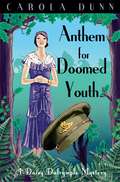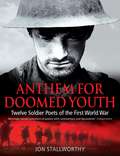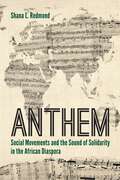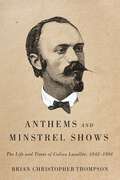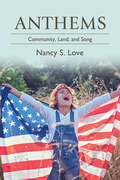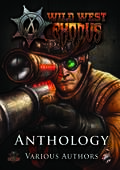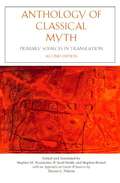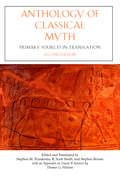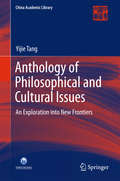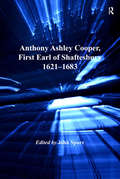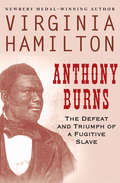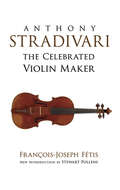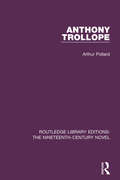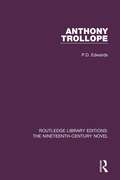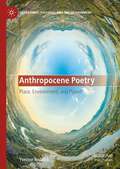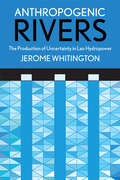- Table View
- List View
Antes de que me olvide: Memorias con Marcelo Ramos
by Luis BrandoniLa autobiografía de Luis Brandoni, uno de los actores más reconocidos de la Argentina, en un relato que entrevera su historia personal desde sus orígenes hasta la actualidad, con su larga trayectoria en cine, teatro y televisión, y una intensa carrera política que va de su activa participación gremial y su persecución durante la dictadura a su involucramiento como funcionario público por el radicalismo. «Un gran actor; de una especie, a mi juicio, en extinción. [De] los que, contando con instrumentos actorales que les permiten transitar con excelencia por gran parte del teatro "culto", tienen una especial capacidad de observación y reproducción de rasgos y conductas de la tipología popular. Y a los que ese don extraordinario los convierte en artistas adorados por los sectores masivos del público. Un público que los vive como cómplices, como parte de su familia».Sergio Renán «Este hombre que había logrado hacerme llorar de risa en un programa de televisión, y de emoción en una película, [ha conseguido hacer] las dos cosas en una misma obra. Beto logra el truco del mago, ese de arrancarte carcajadas y ponerte un nudo en la garganta en un lapso de segundos. Pero hay otra dimensión insoslayable de Beto. Su compromiso con el país, su labor política. [...] De eso habla, y mucho, en estas memorias. Es todo apasionante. Este libro, que es también la historia del teatro y el país de los últimos sesenta años, es un libro para aprender, para regocijarse, para emocionarse. Es para amantes del teatro y amantes del compromiso. Es el backstage de las últimas seis décadas de nuestro país. En él van a poder ver a uno de sus protagonistas, cabeza de compañía, actor de carácter y creador. Un actor, un político y un hombre como muy, muy pocos. "Aprovechenló", ya no hacen gente así».Juan José Campanella A los ochenta años, y con sesenta de trayectoria en cine, teatro y televisión, Luis Brandoni, uno de los actores más famosos de Argentina, nos ofrece por primera vez una mirada precisa, sentida y detallada sobre su vida y su carrera. El relato de su origen en Dock Sud y su vida familiar, el servicio militar y, en orden cronológico: La Comedia Nacional; su experiencia sobre tablas (acá y en el mundo) y en pantalla, de Oscar Viale a Jean Genet y de Luisa Vehil y Migré a Campanella, un vistazo a todas sus películas (de Renán a Cohn-Duprat y Borensztein) y su inclaudicable compromiso político -la pelea por los canales de televisión abierta, la dictadura y el exilio, la experiencia de Teatro Abierto-; y un balance personal que se complementa con una exhaustiva cronología de su obra; la lista de los reconocimientos que ha merecido y un completo índice onomástico que, más allá de su carácter práctico, da cuenta del infinito universo artístico y social al que pertenece.
Anthem
by Ayn RandAnthem, which was written during a break from the writing of the author’s next major novel, The Fountainhead, presents a vision of a dystopian future world in which totalitarian collectivism has triumphed to such an extent that even the word ‘I’ has been forgotten and replaced with ‘we’.The story takes place at an unspecified future date when mankind has entered another Dark Age. Technological advancement is now carefully planned and the concept of individuality has been eliminated. A young man known as Equality 7-2521 rebels by doing secret scientific research. When his activity is discovered, he flees into the wilderness with the girl he loves. Together they plan to establish a new society based on rediscovered individualism.This is the revised version published in 1946, which went on to sell more than 3.5 million copies.
Anthem (The Sixties Trilogy #3)
by Deborah WilesFrom two-time National Book Award finalist Deborah Wiles, the remarkable story of two cousins who must take a road trip across America in 1969 in order to let a teen know he's been drafted to fight in Vietnam. Full of photos, music, and figures of the time, this is the masterful story of what it's like to be young and American in troubled times.It's 1969.Molly is a girl who's not sure she can feel anything anymore, because life sometimes hurts way too much. Her brother Barry ran away after having a fight with their father over the war in Vietnam. Now Barry's been drafted into that war - and Molly's mother tells her she has to travel across the country in an old schoolbus to find Barry and bring him home.Norman is Molly's slightly older cousin, who drives the old schoolbus. He's a drummer who wants to find his own music out in the world - because then he might not be the "normal Norman" that he fears he's become. He's not sure about this trip across the country . . . but his own mother makes it clear he doesn't have a choice.Molly and Norman get on the bus - and end up seeing a lot more of America that they'd ever imagined. From protests and parades to roaring races and rock n' roll, the cousins make their way to Barry in San Francisco, not really knowing what they'll find when they get there.As she did in her other epic novels Countdown and Revolution, two-time National Book Award finalist Deborah Wiles takes the pulse of an era . . . and finds the multitude of heartbeats that lie beneath it.
Anthem for Doomed Youth: A Daisy Dalrymple Mystery (Daisy Dalrymple #19)
by Carola DunnAlec Fletcher's plans to attend his daughter Belinda's school sports day are thwarted by the discovery of three bodies buried in Epping forest. Sent to investigate, he and his team are hindered from the start by uncooperative Essex policeman, DI Gant, who resents Scotland Yard encroaching on his patch. But a bigger problem, however, is identifying the victims and finding a common link between them to explain their being buried so close together, though at intervals of several months.When Alec tells Daisy about the case, she's hooked, and with her own bit of digging around, uncovers the fact that one of the victims was a colonel. Is there a military connection? And when the police eventually discover that the other victims did serve with the colonel, this becomes a tragic case with its roots firmly buried in events during the Great War.Praise for the Daisy Dalrymple series:Cunning ... appropriate historical detail and witty dialogue are the finishing touches on this engaging 1920s period piece. Publisher's Weekly.As always, Dunn evokes the life and times of 1920s England while providing a plot that is a cut above the average British cosy. This will delight readers who love country-house mysteries. Booklist.For fans of Dorothy L.Sayers novels. Library Journal.
Anthem for Doomed Youth: Twelve Soldier Poets of the First World War
by Prof Jon StallworthyLeading poet and former professor of English Literature, Jon Stallworthy, tells the story of the lives and work of twelve major poets of the First World War and provides selections of their best work. The First World War began with flag-waving, parades and poets inspired by abstract ideals. In part this reflected the national mood , but it revealed an almost universal failure to understand what modern mass warfare would really mean. The story of the 'war poets' is also the story of an awakening to the full horror of what the twentieth century came to know as 'The Great War'.Wilfred Owen said, 'My subject is War - and the pity of War'. He also said 'true Poets must be truthful'. The best war poetry was the work of writers who were also serving soldiers and was born out of their desire to tell the truth about what it was to be a soldier in the trenches - what it felt like, what it did to you and what it did to your fellow soldiers, friend or foe. The greatness of the poetry lay not just in the writer's talent, but in the unflinching accuracy with which it portrayed their terrible circumstances.
Anthem: Social Movements and the Sound of Solidarity in the African Diaspora
by Shana L. RedmondFor people of African descent, music constitutes a unique domain of expression. From traditional West African drumming to South African kwaito, from spirituals to hip-hop, Black life and history has been dynamically displayed and contested through sound. Shana Redmond excavates the sonic histories of these communities through a genre emblematic of Black solidarity and citizenship: anthems. An interdisciplinary cultural history, Anthem reveals how this “sound franchise” contributed to the growth and mobilization of the modern, Black citizen. Providing new political frames and aesthetic articulations for protest organizations and activist-musicians, Redmond reveals the anthem as a crucial musical form following World War I.Beginning with the premise that an analysis of the composition, performance, and uses of Black anthems allows for a more complex reading of racial and political formations within the twentieth century, Redmond expands our understanding of how and why diaspora was a formative conceptual and political framework of modern Black identity. By tracing key compositions and performances around the world—from James Weldon Johnson’s “Lift Ev’ry Voice and Sing” that mobilized the NAACP to Nina Simone’s “To Be Young, Gifted & Black” which became the Black National Anthem of the Congress of Racial Equality (CORE)—Anthem develops a robust recording of Black social movements in the twentieth century that will forever alter the way you hear race and nation.
Anthems and Minstrel Shows: The Life and Times of Calixa Lavallée, 1842-1891
by Brian ThompsonFrom Montreal to New Orleans - the music and complex patriotism of the composer of "O Canada."
Anthems: Community, Land, and Song (SUNY series in New Political Science)
by Nancy S. LoveAn examination of struggles for national sovereignty and social justice as seen through patriotic anthems and songs of resistance.Anthems are songs of loyalty and devotion with religious or quasi-religious meanings, typically associated with nation-states. Singing patriotic songs together encourages a sense of shared identity and unified community among citizens. Anthems compares traditional American anthems, such as "The Star-Spangled Banner" and "America the Beautiful," with anthems of resistance from contemporary social movements, such as Occupy Wall Street, Black Lives Matter, and Standing Rock. Although seldom fully recognized by political scientists, musical song plays a significant role in struggles for national unity and social justice. While America's national anthems celebrate a unitary (white) nation, these alternative anthems challenge the definition of sovereignty as property that characterizes modern Western democracies. They offer an alternative vision of a multicultural democracy still struggling to emerge. Written from an interdisciplinary perspective on culture, economics, and politics best described as critical theory, Anthems is intended for scholars, students, and, most important, citizens.
Anthology (Wild West Exodus )
by Brandon RospondBlood drenches the sands of the Wild West as the promise of a new age dies, screaming its last breath into an uncaring night. An ancient evil has arisen in the western territories, calling countless people with a siren song of technology and promises of power and glory the likes of which the world has never known. Forces move into the deserts, some answering the call, others desperate to destroy the evil before it can end all life on Earth.
Anthology of Chinese Literature: From Early Times to the Fourteenth Century (Volume I)
by Cyril BirchInternationally renowned Chinese literature scholar Cyril Birch was the first to assemble the finest translations of these seminal pieces in his now classic and still definitive introductory anthologies. The selections in this first volume span a two-thousand-year period: from the Chou Dynasty (1122–221 B.C.) to the Y’an Dynasty (A.D. 1280–1367), from the ancient Songs to the dramas of the fourteenth century, every major genre of Chinese literature is represented by a crucial work. Highlights include, in addition to the great poems of the T’ang, outstanding examples of Han poetry, Six Dynasties satire, T’ang-sung prose essays and fiction, and the form of lyric known as “tz’u.”
Anthology of Classical Myth
by Stephen Brunet R. Scott Smith Stephen M. Trzaskoma Thomas G. PalaimaThis is a collection of translations of ancient Greek and Roman sources that we have found suitable for teaching classical mythology at the undergraduate level. In that sense, the title is misleading, but Anthology of Stuff That Is Connected in One Way or Another with Mythology in the Ancient World seemed a tad unwieldy to us.
Anthology of Classical Myth: Primary Sources in Translation
by Stephen Brunet R. Scott Smith Stephen TrzaskomaTrzaskoma, R. Scott Smith, and Stephen Brunet (all classics, U. of New Hampshire) have assembled and newly translated ancient Greek and Roman texts relating in one way or another to mythology in the ancient world. They selected those that they have found useful for teaching classical mythology at the undergraduate level. Mostly excerpts, the passages are arranged alphabetically by author. Supporting the anthology are maps; genealogical charts; timelines; appendices on Linear B sources, inscriptions, and papyri; notes on texts and translations, explanations of names and transliteration, and a combination index and glossary. Annotation ©2004 Book News, Inc., Portland, OR (booknews.com)
Anthology of Classical Myth: Primary Sources in Translation
by Stephen Brunet R. Scott Smith Stephen M. TrzaskomaThis new edition of Anthology of Classical Myth offers selections from key Near Eastern texts—the Babylonian Epic of Gilgamesh, Epic of Creation (Enuma Elish), and Atrahasis; the Hittite Song of Emergence; and the flood story from the book of Genesis—thereby enabling students to explore the many similarities between ancient Greek and Mesopotamian mythology and enhancing its reputation as the best and most complete collection of its kind.
Anthology of Philosophical and Cultural Issues: An exploration into new frontiers (China Academic Library)
by Yijie TangThis book argues that a general understanding of traditional Chinese philosophy can be achieved by a concise elaboration of its truth, goodness and beauty; that goodness and beauty in Chinese philosophy, combined with the integration of man and heaven, knowledge and practice, scenery and feeling, reflect a pursuit of an ideal goal in traditional Chinese philosophy characterized by the thought mode uniting man and nature. This book also discusses the anti-traditionalism of the May Fourth Movement, explaining that the true value of "sagacity theory" in traditional Chinese philosophy, especially in Neo-Confucianism in the Song and Ming dynasties, lies in its insights into universal life. In addition, existing ideas, issues, terminologies, concepts, and logic of Chinese philosophical thought were actually shaped by Western philosophy. It is necessary to be alienated from traditional status for the creation of a viable "Chinese philosophy. " "Modern Chinese philosophy" in the 1930s and 1940s was comprised of scholarly work that characteristically continued rather than followed the traditional discourse of Chinese philosophy. That is to say, in the process of studying and adapting Western philosophy, Chinese philosophers transformed Chinese philosophy from traditional to modern. In the end of the book, the author puts forward the idea of a "New Axial Age. " He emphasizes that the rejuvenation of Chinese culture we endeavor to pursue has to be deeply rooted in our mainstream culture with universal values incorporating cultures of other nations, especially the cultural essence of the West.
Anthomaniac Princess: Volume 3 (Volume 3 #3)
by Er Chun"Seventh Prince, have you seen how well I've painted your smoky makeup today?" "Hong Liang, Miss Qiao has a sharp eye. She is to be escorted back to the mansion and is to be accompanied by Su Erzhong to treat Miss Qiao." "Hey, Seventh Prince, don't go yet. There's nothing wrong with my eyes, and I haven't slept for the whole night. I've written a few poems for you, you can listen to them." Seventh Prince was the heavens, Seventh Prince was the earth, and Seventh Prince was the radish and vegetables. Small cool is a flower, small cool is a treasure, small cool is that day fairy. "Ah — the flower and the radish with the fairy, a natural pair!" Just as she finished speaking, the purple-clothed servant girl stood beside the pink-clothed lady with big strides and also held up the cloth in her hand. She recited: "You are the number one marshal in the world, I am the prettiest in the world, you and I love each other and have a fat child to kiss!"
Anthonius Margaritha and the Jewish Faith: Jewish Life and Conversion in Sixteenth-Century Germany
by Michael T. WaltonA biography of Anthonius Margaritha, convert to Christianity and reporter on Jewish life and religious practices.
Anthony Ashley Cooper, First Earl of Shaftesbury 1621–1683
by John SpurrAnthony Ashley Cooper, First Earl of Shaftesbury, was a giant on the English political scene of the later seventeenth century. Despite taking up arms against the king in the Civil War, and his active participation in the republican governments of the 1650s, Shaftesbury managed to retain a leading role in public affairs following the Restoration of Charles II, being raised to the peerage and holding several major offices. Following his dismissal from government in 1673 he then became de facto leader of the opposition faction and champion of the Protestant cause, before finally fleeing the country in 1681 following charges of high treason. In order to understand fully such a complex and controversial figure, this volume draws upon the specialised knowledge of nine leading scholars to investigate Shaftesbury's life and reputation. As well as re-evaluating the well-known episodes in which he was involved - his early republican sympathies, the Cabal, the Popish Plot and the politics of party faction - other less familiar themes are also explored. These include his involvement with the expansion of England's overseas colonies, his relationship with John Locke, his connections with Scotland and Ireland and his high profile public reputation. Each chapter has been especially commissioned to give an insight into a different facet of his career, whilst simultaneously adding to an overall evaluation of the man, his actions and beliefs. As such, this book presents a unique and coherent picture of Shaftesbury that draws upon the very latest interdisciplinary research, and will no doubt stimulate further work on the most intriguing politician of his generation.
Anthony Burns: The Defeat and Triumph of a Fugitive Slave
by Virginia HamiltonThe &“unforgettable&” novel from the Newbery Medal–winning author tells the true story of a runaway slave whose capture and trial set off abolitionist riots (Kirkus Reviews).Anthony Burns is a runaway slave who has just started to build a life for himself in Boston. Then his former owner comes to town to collect him. Anthony won&’t go willingly, though, and people across the city step forward to make sure he&’s not taken. Based on the true story of a man who stood up against the Fugitive Slave Law, Hamilton&’s gripping account follows the battle in the streets and in the courts to keep Burns a citizen of Boston—a battle that is the prelude to the nation&’s bloody Civil War.
Anthony Fokker: The Flying Dutchman Who Shaped American Aviation
by Marc DierikxComprehensive biography of Anthony Fokker, the famed Dutch pilot and daredevil aviatorAnthony Fokker: The Flying Dutchman Who Shaped American Aviation tells the larger-than-life true story of maverick pilot and aircraft manufacturer Anthony Fokker. Fokker came from an affluent Dutch family and developed a gift for tinkering with mechanics. Despite not receiving a traditional education, he stumbled his way into aviation as a young stunt pilot in Germany in 1910. He survived a series of spectacular airplane crashes and rose to fame within a few years. A combination of industrial espionage, luck, and deception then propelled him to become Germany's leading aircraft manufacturer during World War I, making him a multimillionaire by his midtwenties.When the German Revolution swept the country in 1918 and 1919, Fokker made a spectacular escape to the United States. He set up business in New York and New Jersey in 1921, and shortly thereafter became the world's largest aircraft manufacturer. The U.S. Army and Navy acquired his machines, and his factories equipped legendary carriers such as Pan American and TWA at the dawn of commercial air transport.Yet despite his astounding success, his empire collapsed in the late 1920s after a series of ill-conceived business decisions and deeply upsetting personal dramas. In 1927, aviator Richard Byrd solicited a Fokker three-engine plane to be the first to fly non-stop across the Atlantic. The plane was damaged on a test flight and Charles Lindbergh beat him to it. Lindbergh's solo adventure in the Spirit of St. Louis earned him--and cost Fokker--a lasting place in the history books. Using previously undiscovered records and primary sources, Marc Dierikx traces Fokker's extraordinary life and celebrates his spectacular achievements.
Anthony Powell: Dancing to the Music of Time
by Hilary SpurlingThe author of the award-winning, two-volume Matisse: A Life, now gives us the long-awaited, definitive biography of literary master Anthony Powell--the critic, editor, and novelist known as "the English Proust"-- that, at the same time, takes us deep into twentieth-century London literary life.Anthony Powell (1905-2000), best known for his twelve-volume comic masterpiece, A Dance to the Music of Time, was also the author of sixteen earlier novels, plays, and biographies, five memoirs, and three volumes of journals. He was a prolific literary critic and book reviewer. Between the two world wars, before making his name, he kept company with rowdy, hard-up writers and painters--and painters' models--in the London where Augustus John and Wyndham Lewis loomed large. He counted Evelyn Waugh and Henry Green among his lifelong friends, and his circle included the Sitwells, Graham Greene, George Orwell, Philip Larkin, and Kingsley Amis, among many others. Now, drawing on his letters, diaries, and interviews, Hilary Spurling--herself a longtime friend of Powell's-- has written a fresh and masterful portrait of the man, his work, and his time. Insightful, poignant, and cinematic in scope, this biography is as much a brilliant tapestry of a seminal moment in London's literary life as it is a revelation of an iconic literary figure.
Anthony Stradivari the Celebrated Violin Maker (Dover Books on Music)
by Stewart Pollens Francois-Joseph FetisRenowned nineteenth-century musicologist François-Joseph Fétis assembled this authoritative survey with the assistance of noted violin maker and dealer Jean-Baptiste Vuillaume. Focusing on the work of the Italian master violin maker Stradivarius, this volume explores the early history and construction of stringed instruments. In addition, this valuable resource provides rare, contemporary glimpses of the world of Paganini, Schumann, and Berlioz. A reprint of a rare 1864 publication, this study offers intriguing historical information to violinists, music historians, and music lovers of all ages. A new Introduction by famed musicologist Stewart Pollens provides further insights.
Anthony Trollope (Routledge Library Editions: The Nineteenth-Century Novel #32)
by Arthur PollardAnthony Trollope is perhaps best known for the group of Barsetshire novels, a rich and enduring picture of society in a small cathedral town. He also wrote a number of Irish novels and a series about political society known as the ‘Palliser novels’. First published in 1978, this introduction to Trollope’s life and work surveys all of his forty-seven novels, as well as his various miscellaneous works, and calls for a reassessment of his impressive achievement. This book will be of interest to those studying Victorian literature.
Anthony Trollope: His Art And Scope (Routledge Library Editions: The Nineteenth-Century Novel #12)
by P.D. EdwardsFirst published in 1968, this book sets out to refute the idea of Trollope as a ‘mild cathedral-town novelist, describing storms in ecclesiastical tea cups’ which prevailed at the time in spite of his stature during his lifetime. The author reveals the full strength and range of Trollope’s achievement and provides an excellent introduction to further exploration of the novels. Two sections — ‘Narrative Method’ and ‘Subject-Matter’ — are used as the basis from which the author examines key themes in Trollope’s work, with instructive extracts from the novels included to illustrate these points and upon which commentary is provided. This book will be of interest to students of literature.
Anthropocene Poetry: Place, Environment, and Planet (Literatures, Cultures, and the Environment)
by Yvonne ReddickAnthropocene Poetry: Place, Environment and Planet argues that the idea of the Anthropocene is inspiring new possibilities for poetry. It can also change the way we read and interpret poems. If environmental poetry was once viewed as linked to place, this book shows how poets are now grappling with environmental issues from the local to the planetary: climate change and the extinction crisis, nuclear weapons and waste, plastic pollution and the petroleum industry. This book intervenes in debates about culture and science, traditional poetic form and experimental ecopoetics, to show how poets are collaborating with environmental scientists and joining environmental activist movements to respond to this time of crisis. From the canonical work of Ted Hughes and Seamus Heaney, to award-winning poets Alice Oswald, Pascale Petit, Kei Miller, and Karen McCarthy Woolf, this book explores major figures from the past alongside acclaimed contemporary voices. It reveals Seamus Heaney’s support for conservation causes and Ted Hughes’s astonishingly forward-thinking research on climate change; it discusses how Pascale Petit has given poetry to Extinction Rebellion and how Karen McCarthy Woolf set sail with scientists to write about plastic pollution. This book deploys research on five poetry archives in the UK, USA and Ireland, and the author’s insider insights into the commissioning processes and collaborative methods that shaped important contemporary poetry publications. Anthropocene Poetry finds that environmental poetry is flourishing in the face of ecological devastation. Such poetry speaks of the anxieties and dilemmas of our age, and searches for paths towards resilience and resistance.
Anthropogenic Rivers: The Production of Uncertainty in Lao Hydropower (Expertise: Cultures and Technologies of Knowledge)
by Jerome WhitingtonIn the 2000s, Laos was treated as a model country for the efficacy of privatized, "sustainable" hydropower projects as viable options for World Bank-led development. By viewing hydropower as a process that creates ecologically uncertain environments, Jerome Whitington reveals how new forms of managerial care have emerged in the context of a privatized dam project successfully targeted by transnational activists. Based on ethnographic work inside the hydropower company, as well as with Laotians affected by the dam, he investigates how managers, technicians and consultants grapple with unfamiliar environmental obligations through new infrastructural configurations, locally-inscribed ethical practices, and forms of flexible experimentation informed by American management theory.Far from the authoritative expertise that characterized classical modernist hydropower, sustainable development in Laos has been characterized by a shift from the risk politics of the 1990s to an ontological politics in which the institutional conditions of infrastructure investment are pervasively undermined by sophisticated ‘hactivism.’ Whitington demonstrates how late industrial environments are infused with uncertainty inherent in the anthropogenic ecologies themselves. Whereas ‘anthropogenic’ usually describes human-induced environmental change, it can also show how new capacities for being human are generated when people live in ecologies shot through with uncertainty. Implementing what Foucault called a "historical ontology of ourselves," Anthropogenic Rivers formulates a new materialist critique of the dirty ecologies of late industrialism by pinpointing the opportunistic, ambitious and speculative ontology of capitalist natures.

